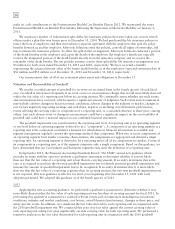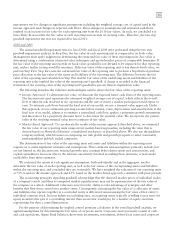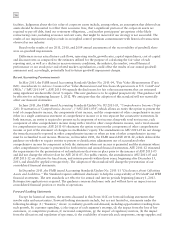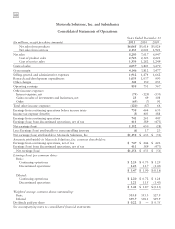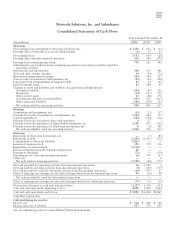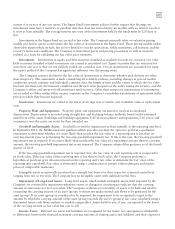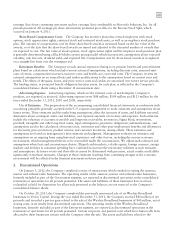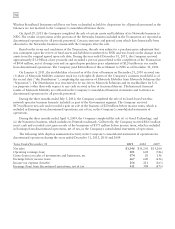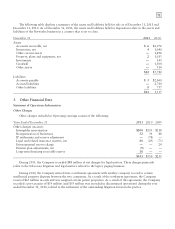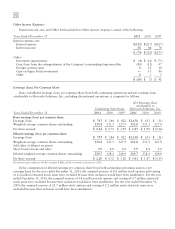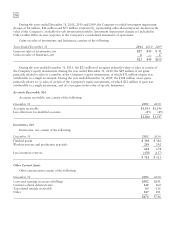Motorola 2011 Annual Report Download - page 70
Download and view the complete annual report
Please find page 70 of the 2011 Motorola annual report below. You can navigate through the pages in the report by either clicking on the pages listed below, or by using the keyword search tool below to find specific information within the annual report.
64
Motorola Solutions, Inc. and Subsidiaries
Notes to Consolidated Financial Statements
(Dollars in millions, except as noted)
1. Summary of Significant Accounting Policies
Principles of Consolidation: The consolidated financial statements include the accounts of Motorola
Solutions, Inc. (the “Company” or “Motorola Solutions”) and all controlled subsidiaries. All intercompany
transactions and balances have been eliminated.
The consolidated financial statements as of December 31, 2011 and 2010 and for the years ended
December 31, 2011, 2010 and 2009, include, in the opinion of management, all adjustments (consisting of normal
recurring adjustments and reclassifications) necessary to present fairly the Company’s consolidated financial
position, results of operations and cash flows for all periods presented.
The preparation of financial statements in conformity with U.S. GAAP requires management to make certain
estimates and assumptions that affect the reported amounts of assets and liabilities and disclosure of contingent
assets and liabilities at the date of the financial statements and the reported amounts of revenues and expenses
during the reporting periods. Actual results could differ from those estimates.
Changes in Presentation
During 2011, the Company reclassified the historical financial results of the following businesses as
discontinued operations: (i) Motorola Mobility Holdings, Inc. (“Motorola Mobility”), (ii) Point-to-Point
(Orthogon) and Point-to-Multipoint (Canopy) wireless broadband businesses (“Wireless Broadband businesses”),
and (iii) the amateur, marine and airband radio businesses. Also during 2011, we completed the sale of certain
assets and liabilities of the Networks business to NSN (the “Transaction”), which was reclassified to discontinued
operations during 2010. The results from discontinued operations are discussed in further detail in the
“Discontinued Operations” section.
Reverse Stock Split and Name Change
On January 4, 2011, immediately following the Distribution of Motorola Mobility common stock, the
Company completed a 1-for-7 reverse stock split (“the Reverse Stock Split”) and changed its name to Motorola
Solutions, Inc. All consolidated per share information presented gives effect to the Reverse Stock Split.
Revenue Recognition: In October 2009, the Financial Accounting Standards Board (“FASB”) issued guidance
which amended the accounting standards for revenue arrangements with multiple deliverables and the scope of
software revenue recognition guidance. This guidance changed the criteria required to separate deliverables into
separate units of accounting when they are sold in a bundled arrangement and established a hierarchy for
determining the selling price to be used to allocate revenue to each deliverable. Additional guidance removed
software from the scope of software revenue recognition guidance for tangible products containing software
components and non-software components that function together to deliver the tangible product’s essential
functionality. The Company adopted this guidance as of the beginning of its first quarter of fiscal 2010 on a
prospective basis for arrangements entered into or materially modified after January 1, 2010. These changes have
been incorporated in the discussion of the Company’s revenue recognition policies that follow.
Net sales consist of a wide range of activities including the delivery of stand-alone equipment, custom design
and installation over a period of time, and bundled sales of equipment, software and services. The Company enters
into revenue arrangements that may consist of multiple deliverables of its product and service offerings due to the
needs of its customers. The Company recognizes revenue when persuasive evidence of an arrangement exists,
delivery has occurred, the sales price is fixed or determinable, and collectability of the sales price is reasonably
assured. The Company recognizes revenue from the sale of equipment, software bundled with equipment that is
essential to the functionality of the equipment, and most services in accordance with general revenue recognition


